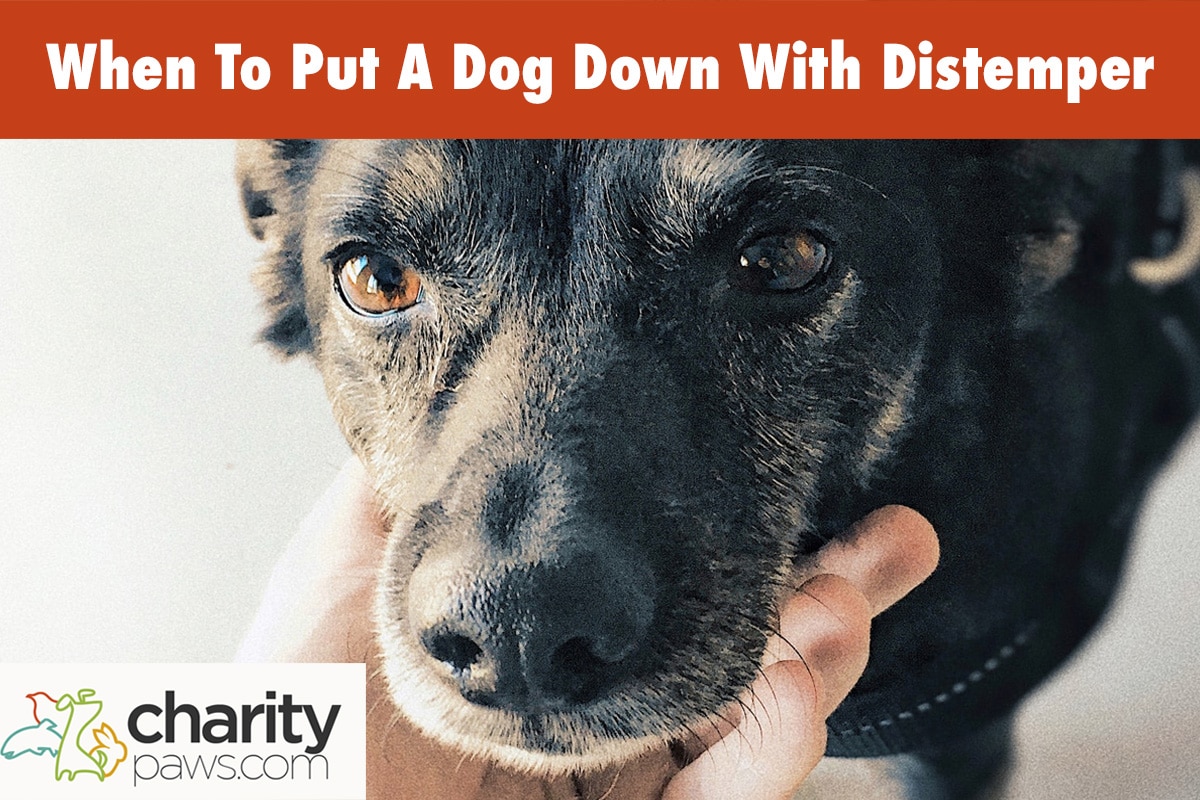Canine distemper is a devastating illness that takes the lives of so many beloved pups.
Those that do survive the virus are often left with long term complications, proving just how impactful this infectious disease can be.
If your dog has just been diagnosed with distemper, you are likely wondering what this means for them moving forward.
Will they survive, will they be left with permanent damage, or will you even need to say goodbye at some point?
If you do need to make that difficult decision, how will you know it’s time?
Before we can answer when to put a dog down with distemper, we first need to understand what could lie ahead for your dog with this illness.

What Exactly Is Distemper In Dogs?
Before we answer the question of when to euthanize a dog with distemper, we should first give you a quick rundown of the virus itself.
Canine distemper virus (CDV) is a viral disease that targets:
- The respiratory tract
- Gastrointestinal tract
- Central nervous system
With impacting multiple body systems in our canine friends, this will often lead to fatal complications.
Distemper is highly contagious, and is spread from dog to dog through direct contact with infected bodily secretions.
The most common way that the disease is spread is through aerosolized droplets from sneezing and coughing, as these droplets are easily inhaled by dogs in close range.
Dogs can also contract the disease by coming in contact with contaminated surfaces like dog bowls and bedding, as well as puppies coming in contact with their infected mother’s bodily secretions.
Once the virus makes its way into the body, a complicated disease process occurs behind the scenes.
Like many other viruses that impact our canine friends, there is no set cure for distemper.
The only way to help a dog or puppy through the condition is with aggressive supportive care, as well as combating any secondary infections that occur along the way.
Even with offering the gold standard of care, many dogs still will not survive.
What Are The Symptoms Of Canine Distemper
Due to the fact that canine distemper can impact multiple body systems, this means that you will often see an array of symptoms in the affected pup.
Some cases of canine distemper will also impact certain systems more than others, so it’s important to understand the potential symptoms of each form of CDV.
To help you better understand what CVD can look like, let’s break it down based on which body system the virus reaches.
First Signs Of Distemper
- Anorexia
- Nasal discharge
- Fever
- Conjunctivitis
- Lethargy
Respiratory Symptoms Of Distemper
- Conjunctivitis
- Anorexia
- Fever
- Coughing
- Sneezing
- Nasal discharge, often thick
- Labored breathing
Gastrointestinal Symptoms Of Distemper
- Lethargy
- Fever
- Anorexia
- Vomiting
- Diarrhea
- Abdominal pain
Central Nervous System Symptoms Of Distemper
- Lethargy
- Weakness
- Fever
- Twitching muscles
- Unsteady gait
- Wobbly stance
- Hypersensitivity to stimuli
- Increased vocalizations
- Seizures
- Collapse
- Paralysis
- Thickening of the paws pads and nose
Some dogs with distemper will only ever develop initial symptoms of CDV along with mild respiratory symptoms, while others will develop severe central nervous system signs.
It’s also important to keep in mind that while some dogs will only have mild symptoms initially, the virus can hide out in their central nervous system and flare up at a later date.
So while some dogs will appear to have only had a mild case of the disease, they may actually develop severe neurological symptoms a few months down the line.
This is why canine distemper is such a tricky condition to maneuver, because it will take several months for you to know whether or not your dog can truly survive this.
Many dogs will also have long term neurological damage even if they do survive the virus, with many pups going on to have permanent tremors and seizures.
What To Do If My Dog Has Distemper
If you think your dog has come in contact with distemper, you must keep a very close eye on them for the following 4-6 weeks.
Initial symptoms will typically develop within 1-4 weeks of exposure, and these first symptoms can range from slight nasal discharge to GI upset.
If your dog has in fact contracted canine distemper, fast action is essential in offering them the best chance at survival.
It’s also important to make sure that you quarantine your pup during the 4-6 weeks after exposure, as they may be infectious in the time period if they have indeed caught the virus.
Due to how highly infectious this virus is, keeping your pup away from other dogs can prevent the virus from spreading.
If your dog does develop symptoms of canine distemper, we suggest having them seen as quickly as possible.
CDV can quickly progress into a life threatening situation, and requires immediate supportive care to help pull them through.
This condition is fatal when treatment is not sought, and will result in unnecessary suffering for the furry friend that is infected.
How Is Distemper Treated In Dogs?
As we mentioned above, the only way to address canine distemper in dogs is through aggressive supportive care.
There is no set treatment for this deadly virus, and every case will require individual care that addresses their current symptoms.
Treatment will also involve preventing other secondary infections from developing, as these pups are incredibly susceptible to systemic infections at this point.
Immediate hospitalization paired with intensive nursing care is the best way to treat cases of canine distemper virus.
Most treatment plans for distemper virus in dogs include:
- Hospitalization
- IV fluids
- Antibiotics for secondary infections
- GI medications that manage any vomiting or diarrhea
- Anti-seizure medications for any neurological symptoms
- Oxygen therapy for any respiratory complications
Some dogs require aggressive care for anywhere from 1-3 weeks based on the severity of their symptoms, but many will not survive this long.
If a dog does survive their CDV infection, you will need to monitor the pup closely for the months to come.
Due to the fact that distemper can hide out in the body and flare up at a later date, some dogs will fall ill once again down the line.
I once had a patient that only had mild respiratory symptoms when he was first diagnosed, and though he appeared to survive the initial infection, he developed seizures 1 month down the line and passed away.
Even with aggressive care, many dogs with distemper will still die as a result of severe neurological symptoms, as well as systemic infections.
Distemper is the second most deadly infectious virus in dogs, with rabies being the first on the list.
How Long Can A Dog Live With Distemper?
It is difficult to determine an average life expectancy for distemper in dogs, because dogs that acquire the infection have varying degrees of complications.
Some dogs will survive mild cases of distemper that do not result in permanent damage, while others will develop neurological distemper and pass away a few weeks after being infected.
The only statistics gathered for distemper is a 50% mortality rate in adult dogs and an 80% mortality rate in puppies (Cornell.edu), but there is no concrete life expectancy on dogs that survive with permanent damage.
It is not far off to assume that distemper has the ability to shorten a dog’s lifespan even when they survive the infection, especially if they have neurological damage.
The only example of a dog surviving a distemper infection that I have seen is a dog that is owned by a veterinarian I worked with previously.
She rescued a 4-month-old puppy with distemper and nursed her to health, and she was able to survive the illness after weeks of intensive care.
Though she survived CDV, she still battles severe neurological symptoms to this day.
She is now 6-years-old and doing fine, but she still has persistent tremors and a few seizures a month.
While we can’t know how this will impact her life in the coming years, I can imagine that this has the ability to shorten her lifespan.
Every case will vary, so your vet is the only one that can offer you an accurate prognosis for your pup’s life moving forward.
Though canine distemper can be mysterious in many ways, your vet will still understand your dog’s situation best.
Can Distemper Be Prevented Or Cured?
Thankfully for the beloved pups in our lives, canine distemper can be prevented with a vaccine.
Dogs will need an initial series of three vaccines spaced apart by three weeks during their first year of their life, a booster one year later, then a booster every 3 years moving forward.
This is often a combination vaccine that also protects against parvovirus, so this is an essential vaccine for all canine companions.
In addition to vaccinating your pup we suggest staying away from public settings until your dog is fully vaccinated, avoiding contact with any dogs with respiratory symptoms, using cautions in settings that frequent a high volume of dogs, and even avoiding public water stations for dogs.
There is no cure for canine distemper, so it is up to us to protect our pups from this serious threat.
By fully vaccinating your dog and practicing caution in public settings, most pups can remain safe throughout their lives.
When To Euthanize My Dog With Distemper
If you are wondering when to put a dog down with distemper, is it likely because you don’t want your dog to suffer in any way.
Distemper is a devastating virus that can deeply impact a dog’s health in the weeks after infection, but also in the years to follow for some pups.
We never want our pups to endure unnecessary pain, so it’s important to understand when it may be time to say goodbye in these situations.
In most cases, dogs with distemper have the worst prognosis when they have already developed neurological symptoms.
While some dogs may still survive with aggressive care, this is not often the case.
If your dog has developed muscle tremors, nystagmus, seizures, ataxia, or a wobbly gait, we suggest speaking with your vet about a realistic prognosis.
If your vet agrees that they will not likely improve, it may be time to say goodbye.
Another time in which you should strongly consider euthanasia is if you are unable to offer medical treatment for any reason.
Dogs with distemper will quickly decline without medical intervention, and they may soon begin to suffer if aggressive care is not sought.
We understand that treatment is not always an option for some families, so sometimes saying goodbye is the kindest route to take.
Some people opt to surrender their dog to a shelter or local rescue because they cannot afford to take care of them.
If you have any specific questions about your dog’s case, we suggest speaking directly with your veterinarian.
They are the only ones that know the details of your dog’s situation, so they can offer the best advice if you are struggling with this decision.
Final Thoughts On When To Euthanize A Dog With Distemper

Canine distemper virus is a terrifying diagnosis that no pet parent wants their pup to endure.
If your dog has distemper and you are struggling with making a decision on what to do, reach out to your veterinarian.
Even a local dog rescue can give you advise or help as they have most likely experienced dogs with distemper.
With the help of your dog’s veterinary team, you can make the best decision regarding their care and if they suggest euthanasia, you can know you made the right decision.

